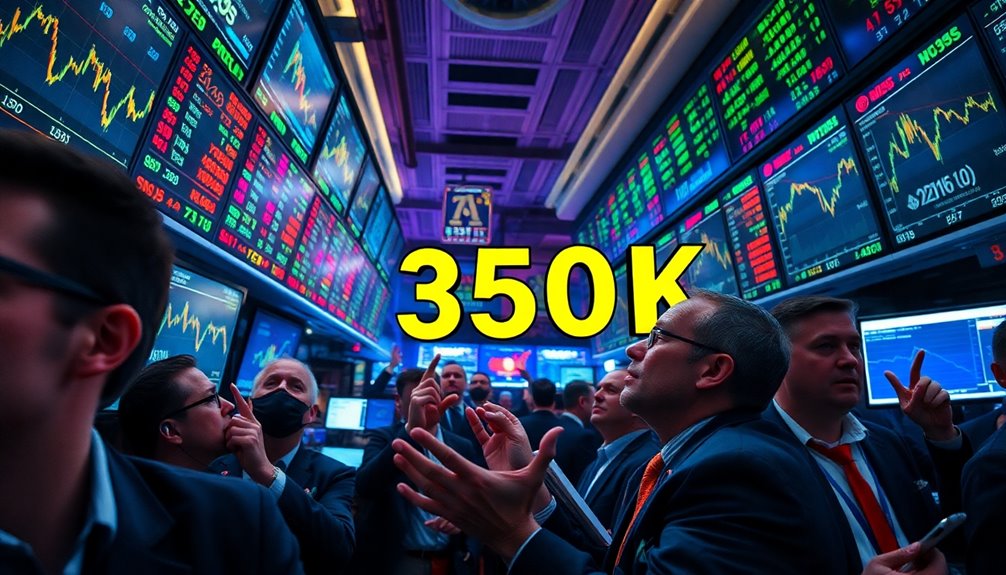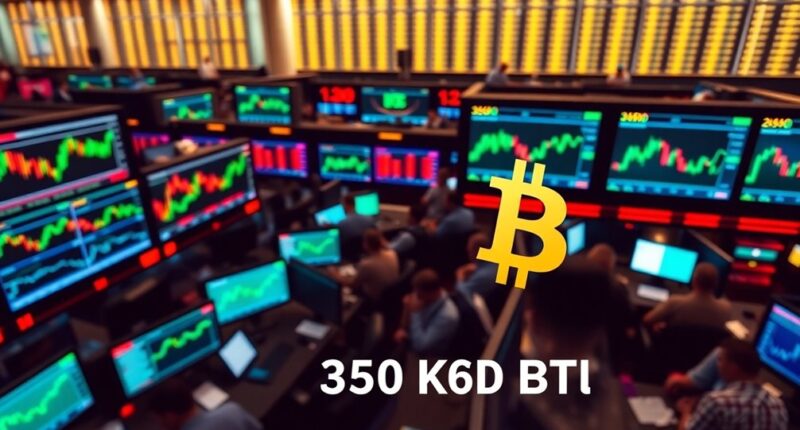Bitcoin's open interest has surged to 350,000 BTC, signaling significant market growth and increased participation from traders. This rise means more contracts are being opened than closed, suggesting a bullish sentiment among market players. With heightened open interest, you can expect stronger price trends, especially during Bitcoin's halving cycle. Both institutional and retail investors are showing a growing interest, driven in part by recent regulatory changes that enhance market confidence. As the market evolves, there's plenty to explore about how these shifts may impact future performance and opportunities for investors like you.
Key Takeaways
- Bitcoin's open interest has reached 350,000 BTC, indicating increased market participation and engagement among traders.
- A rise in open interest suggests a bullish sentiment, reflecting confidence in Bitcoin's price trends during its halving cycle.
- Institutional investments, fueled by spot Bitcoin ETF approvals, have contributed significantly to the surge in open interest and overall market liquidity.
- Increased open interest, now at a record high of $32.9 billion, indicates heightened speculation and potential for market volatility.
- The current environment of regulatory clarity and rising trading volume fosters a positive outlook for Bitcoin's market growth.
Bitcoin's Rising Open Interest

Bitcoin's rising open interest is capturing the attention of traders and investors alike. Open interest represents the total number of active derivative contracts that remain unsettled, offering a snapshot of market activity. When more contracts are opened than closed, this figure increases, signaling growing participation. Currently, Bitcoin's open interest has surged to 350,000 BTC, indicating heightened interest from both institutional and retail investors. This level, while below its all-time high, suggests significant room for expansion. A high open interest is a classic bullish signal, especially as Bitcoin approaches a historically bullish phase in its halving cycle. This increase in open interest often confirms the strength of price trends, pointing to potential upward momentum in the market, making it an exciting time for traders.
Regulatory Changes Impact Trading Volume

As regulatory changes continue to shape the cryptocurrency landscape, their impact on trading volume becomes increasingly evident.
The approval of spot Bitcoin ETFs has spurred over $19 billion in institutional investments, signaling greater mainstream acceptance of Bitcoin. This regulatory clarity fosters confidence among retail and institutional investors, directly boosting trading volume. Notably, high Bitcoin trading volume signals strong market activity and liquidity, which further encourages participation.
With the SEC's recent approval marking a significant shift, you're likely to see increased liquidity in the market. Anticipation surrounding regulatory decisions has historically influenced Bitcoin's price, creating a ripple effect on trading activities.
Investor Sentiment and Volatility

The surge in Bitcoin's open interest signals a growing bullish sentiment among traders, reflecting increased market activity and speculation.
With open interest reaching a record high of $32.9 billion, you can see that traders are entering more futures contracts, betting on Bitcoin's price rise. This increase in aggregate leverage points to heightened market volatility, as speculators amplify their potential gains.
While Bitcoin's bullish outlook contrasts with struggling altcoins, the market remains sensitive to macroeconomic factors. Notably, the increased open interest indicates a significant shift in investor sentiment, which could lead to further price fluctuations.
You should be aware that implied volatility is also rising, indicating cautious optimism among investors.
Balancing opportunity with risk management is crucial, especially as immediate concerns could lead to sharp price swings.
Stay alert; the market's temperament can shift quickly.
Corporate Investment Strategies

Navigating the corporate investment landscape in cryptocurrency requires a strategic approach, and many companies are seizing the opportunity to integrate Bitcoin into their portfolios.
Direct investment, exemplified by MicroStrategy's significant purchases, highlights how firms view Bitcoin as a treasury reserve asset. This move aims to preserve capital while potentially yielding better returns than cash. With improved regulations and accounting standards, more corporations are joining the trend. Additionally, investing in cryptocurrency-focused companies and decentralized finance (DeFi) can offer indirect Bitcoin exposure. Implementing risk management strategies is essential for companies to safeguard their investments against market volatility.
Utilizing crypto derivatives like futures and ETFs further diversifies investment strategies while managing volatility. As institutional interest grows, it's crucial for you to consider these strategies carefully to enhance your corporate financial outlook. Furthermore, the increasing adoption of cryptocurrency by businesses and financial institutions globally is reshaping the investment landscape.
Election Outcomes and Market Reactions

While election outcomes often sway investor sentiment, the recent surge in Bitcoin prices following Trump's victory underscores the profound impact political events can have on the cryptocurrency market.
Bitcoin skyrocketed to over $75,000, marking an 8% increase in early trading. This surge also boosted altcoins like Ethereum and Dogecoin, contributing to a broader market rally.
As trading volumes spiked, heightened volatility marked the market, reflecting rapid price fluctuations in response to the election outcome. Investors are optimistic about a more crypto-friendly environment, especially with potential regulatory shifts under Trump's leadership. This optimism is fueled by Trump's past commitment to removing SEC Chair Gary Gensler, who has been viewed negatively by crypto advocates.
Historical trends suggest that post-election periods typically yield positive movements, reinforcing investor confidence and driving interest in digital assets.
Long-Term Bullish Price Predictions

Amidst the growing interest in cryptocurrencies, optimistic long-term price predictions for Bitcoin have captured the attention of investors.
Bernstein analysts forecast Bitcoin could hit $200,000 by 2025, driven by strong inflows into spot U.S. Bitcoin ETFs. Additionally, the recent surge in Bitcoin market growth indicates a robust bullish sentiment that could further encourage investment.
Max Keiser believes this milestone could come even sooner, predicting $200,000 in 2024. The anticipated growth in solar energy adoption may influence the cryptocurrency landscape by promoting sustainable mining practices.
Fidelity takes a bold stance, projecting Bitcoin could reach $1 billion by 2038, emphasizing its potential as a store of value. Hal Finney's prediction of $22 million by 2045 highlights the long-term growth outlook.
With increasing institutional adoption, combined ETF assets could soar to $190 billion by 2025, suggesting a bullish sentiment that could reshape the financial landscape.
Frequently Asked Questions
What Is Open Interest in Bitcoin Trading?
Open interest in Bitcoin trading refers to the total number of outstanding futures or options contracts that traders are holding.
It helps you gauge market sentiment, showing whether traders are feeling bullish or bearish.
When open interest rises, it usually means more contracts are being opened than closed, indicating increased trading activity and liquidity.
How Does Open Interest Affect Bitcoin Price Movements?
Imagine open interest as the heartbeat of the Bitcoin market; when it beats stronger, prices often rise.
As open interest increases, it signals new capital flowing in, boosting confidence among traders.
Conversely, a drop in open interest can foreshadow price declines, reflecting waning interest.
What Are the Risks of High Open Interest in Bitcoin?
High open interest in Bitcoin poses several risks for you as a trader.
You might experience increased volatility, leading to unpredictable price swings or even flash crashes.
Liquidity can drop, making it tough to execute trades without affecting prices.
Misinterpretation of market sentiment might occur, causing you to rely too heavily on open interest rather than other indicators.
Plus, managing positions becomes harder, increasing the risk of significant financial losses.
Can Open Interest Indicate Market Manipulation?
Open interest can definitely indicate market manipulation. When you see high open interest, it might signal pump-and-dump schemes or spoofing tactics, where traders create false demand.
Conversely, low open interest often points to a shallow market, making it easier for manipulators to influence prices.
By monitoring changes in open interest alongside price movements, you can detect potential manipulation and make more informed trading decisions.
Always stay vigilant!
How Is Open Interest Calculated for Bitcoin Futures?
Think of open interest like a bustling marketplace, where each new position adds to the total outstanding contracts.
To calculate it, you track new buyers and sellers; each transaction creates one contract. If someone closes a position while another takes it, the open interest stays the same.
Conclusion
As Bitcoin's open interest soars to 350,000 BTC, you can see the stark contrast between cautious investors and those diving headfirst into the market. While regulatory changes create uncertainty, they also spark new opportunities for growth. You might feel the tension between volatility and bullish predictions, but that's the nature of investing. Embrace the dynamics at play—while some hesitate, others are seizing the moment, shaping the future of Bitcoin and its potential for long-term success.










